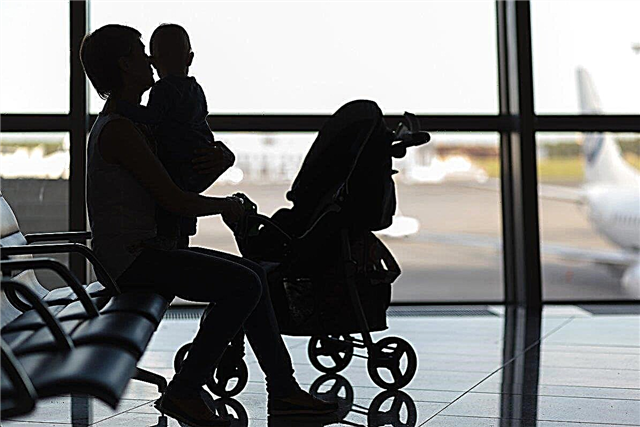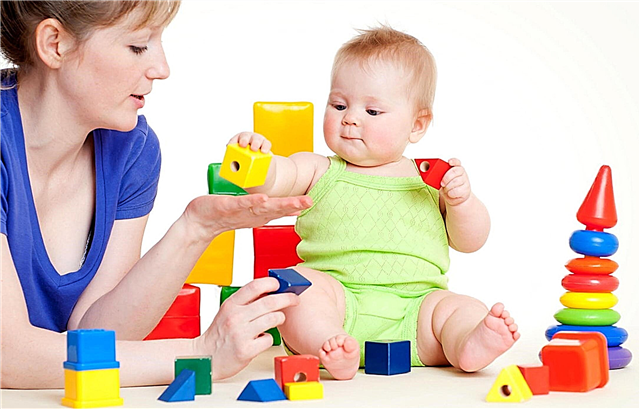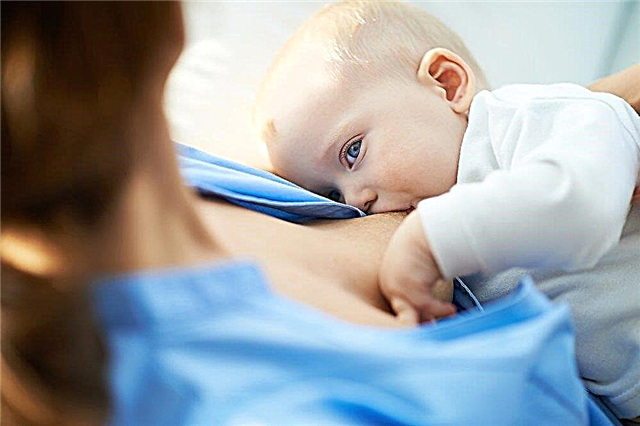A four-month-old baby is an active, agile and emotional baby. By the age of four months, the newborn is trying not only to reach for the toy that lies nearby, but also to try to crawl to it clumsily. The baby begins to eat more breast milk or an adapted formula, some mothers try to feed the baby with a different diet: fruit or vegetable juices. The little fidget wants to know everything, to consider, to do something while lying on his tummy. Life becomes much brighter - it's time to hone the acquired skills. What a child should be able to at 4 months old and what necessary skills to master is important for every parent to know in order to avoid negative consequences in the future.

The baby smiles consciously
Basic skills
The fourth month is characterized by the transition from a reflexive and unconscious life to a more volitional one. The baby is trying to understand his body and learn its signals. A 4-month-old baby actively gets to know the outside world, showing initiative, influencing and looking at the reaction. Four months is a milestone in development, henceforth the baby will grow more conscious, mature and delight parents.
What can a baby at 4 months do:
- Rolls over on its own and back. When he lies on his tummy, he raises the body of the body, rests on his palms and holds himself in this position for some time.
- When lying on the back, he tries to raise his shoulders and head.
- The movements of the hands become accurate and confident, the baby tries to control them himself, hold the toy for about a minute, smile at her, hold his mother by the finger or hug him during feeding, take his bottle.
- When he cries, tears appear in his eyes - a sign that the lacrimal glands are fully formed.
- The most pleasant news for many parents: at the end of the 3rd month (in the third or fourth week) - at the beginning of the 4th month, colic disappears, so the work of the gastrointestinal tract becomes normal.
- Hearing sharpens and develops actively - the baby turns towards the sound source.
- The eye muscles have strengthened enough, which is why strabismus (if it is not caused by congenital, intrauterine pathology or is not inherited), as well as weakness of the eye muscles remain in the past.
- If the baby is pulled on the handles while lying on the back, he will try to sit down.
Important! The fourth month is a very early period for purposeful sitting down. The baby's spine is not yet fully strengthened, so such loads will be dangerous. As a rule, the baby tries to master this skill by the end of the fifth month or even later, which indicates a readiness for such skills. Early sitting down for girls is especially dangerous - this can cause abnormal formation of the uterus and problems with pregnancy and bearing in the future. Boys do not have such consequences, but, nevertheless, it is not worth sitting them down either.

The kid tries to reach for toys
Differences between girls and boys
There are no significant differences between both sexes. However, Dr. Yevgeny Komarovsky, a renowned pediatrician and Ph.D., says the difference can still be caught. If you draw parallels, you can find the following nuances.
Features of the development of boys and girls
| Sphere | Boys | Girls |
|---|---|---|
| Intrauterine development and childbirth | The embryo is more stressed and at risk of premature birth and has to struggle to survive. The boy's brain is tuned for improvement and progress. | They develop faster after childbirth. Are born more mature and fit. The girl's brain is tuned for survival. |
| Physical | Breathing is abdominal. The lungs are larger than those of girls. Strong, agile. See better with the left eyes. Spatial vision is more developed. Recognizes the blue spectrum of colors. Audials. | Breathing is chest. Hardier than boys. Good response to loud sound. Better face recognition. Two eyes are equally developed, vision is peripheral. Recognizes the red spectrum of colors. They start to speak earlier, the vocabulary is more developed. Visuals. |
| Mental | The left hemisphere matures more slowly. Visual-figurative perception. | The right hemisphere matures more slowly. "Speech" perception of the world, due to the early skill of speaking. |
| Emotional | Are more restless and sleep less. They react with tears to everything new around. | Crying is usually caused by lack of attention. Girls need more attention and conversation. |
The main skills of the period, what a baby should and can be able to do at 4 months:
- The head is held very well, the baby can look at everything around for a long time. Begins to try to lean on elbows, rise and stand on hands.
- The coups from the back are completely mastered. The most restless toddlers try to crawl, helping themselves with their legs.
Note! You cannot leave the baby on the bed or sofa - at the time of the coups, he may fall.
- Lying on his back, trying to sit up, raising his head and shoulders. You can try to stimulate this process and give him a toy from your hands - this will strengthen the shoulder girdle.
- Works out "tweezers" grip. The kid tries to touch everything, hold his hands, control them. In the crib, the baby touches everything and stimulates the work of the fingertips.
- In moments of play, communication, he begins to express emotions: joy, surprise, anxiety, or begins to cry. The range of emotions becomes wider.
- The humming becomes prolonged. Sometimes, waking up at night, he can talk for a long time, conduct "conversations" with himself. Uttering some sounds, he tries to listen to them.
Physical development
This month is indicative in that most of the reflexes fade away: the grasping reflex disappears, the baby chooses what toy to take. Weight and body parameters are added: body weight can grow by 750 grams, height - by 2.5 cm.

Brief table of physical indicators
What are the manifestations in physics:
- The crumb stopped "blooming" - the pimples disappeared.
- Salivation increases. This is due to the fact that the baby is trying to try everything on the "tooth", pulls everything into his mouth. Some babies may start to have teeth at 4.5 months.
Additional Information. It is worth removing small parts, toys, buttons and peas away from the baby - the baby can suffocate or swallow them.
Perception of the surrounding world
By this period, the baby begins to see well into the distance. He is able to distinguish an object at a distance of 3-3.5 meters. In view of this, while on a walk, you can take him in your arms, show everything around, talk and talk about what is happening. This exercise can be used at home, so that the baby learns the environment and trains his eyes.

Curiously, the baby explores everything around
Important! The child already distinguishes the faces of the parents, rejoices when he sees them. Now he begins to smile not just to the kind people who took him in their arms, but especially to dad and mom.
Hearing also contributes to the perception of the outside world. You can start listening to classical music with your child, read fairy tales, and sing. The kid will not catch the meaning, but the intonation, color, timbre, voice. He will remember all this and carry it through the years - in difficult life situations he will hear the voice of his mother inside. The baby also reacts to the loud voice of the parents, is afraid and starts crying, so you should not swear in front of him. Speech becomes more melodious, emotional - the baby tries to imitate his parents, publishing meaningless syllables.
Social skills
The baby's brain develops quickly, social reactions to a positive stimulus appear soon enough: interest, joy.
What an infant needs to master socially:
- To smile, to understand what a smile is, to react with it when an adult appears.
- Laugh, move your arms and legs when it's fun.

The baby begins to recognize himself in the mirror and smile
- Walk around for a long time, make throat sounds, intonations and try to hear them.
- React to your own name when it is spoken.
- Rejoice at the sight of your favorite toy and when a new one appears.
- Follow with your eyes what moves: a toy, a rattle, animals, parents.
- Reacting to your favorite music sometimes helps to calm down a crying baby, he may even begin to sing along with syllables.
- Clearly highlight the voice of mom and dad, as well as those voices that he often hears.
Additional Information. Mom and Dad are especially happy with the "revitalization complex" of the crumbs: seeing the parents, he begins to laugh out loud, flounder with his limbs and try to grab the hands of his loved ones.
Psycho-emotional development
A four-month-old child has very developed emotions, feelings become richer, the psyche is actively developing.
Emotional development is distinguished by the following factors:
- Animation at the sight of familiar faces.
- Seeing her mother, she chirps and hums happily.

The child is always glad to his mother, radiates joy and a smile
- Rejoices at his reflection.
- Much babbling in speech. Sometimes there are "ba", "ma", "pa", but they, rather, are not realized.
- Anger, resentment, anger are added to joy and sadness, the spectrum of emotions expands.
- Behavior is differentiated: you like to play - you are happy, the game stops - you cry. Selects favorite toys to play with.
- Turns to the sound of music, highlights rhythmic, melodic music.
- Listens to the pronunciation of his name.
- He gets to know his body, feels it in space, gazes intently at his palms and feels his legs. He learns everything through play.
- Vision becomes at the level of an adult, distinguishes colors.
What promotes development
In order for the baby to develop actively, it is possible and necessary to deal with him:
- Hang toys over the kid (buy a carousel) - he will be able to grab, feel, examine. It is better if they are of different texture and musical.
- Develop fine motor skills: give rattles of various shapes, soft toys, rubber tweeters to touch.
- The game of "hide and seek": cover your face with your palms, and, opening, say "cuckoo". You can also cover your baby's eyes, and then your own. Children are very happy with this fun.
- The game "magpie-crow": there are centers on the palm that stimulate the intestines. The game will help both arm muscles and digestion.
- Blowing bubbles: the baby will watch how they slowly fall.
- Put on a sock of a bright color on the baby's leg so that he can take it off himself, reach out.
- Coordination training: slowly raise the baby's arms and lower them down, then cross them on the chest and spread them apart.
- In moments of gymnastics, sing him songs, talk, read rhymes, nursery rhymes. You can sing lullabies at night.
- Clearly conduct a "dialogue" with the baby, he will see facial expressions and strive to imitate.

The presence of special toys promotes development
Note! The crumb learns the world through the game, therefore, in order for development to proceed successfully and without tears, it is worth turning the entire learning process into entertainment.
There is a whole range of activities that contribute to psychological development:
- Regular walks in the fresh air.
- Breastfeeding or the correct formula on schedule.
- Swimming in warm water every day, if you wish - you can go to the pool for baby swimming.
- Massage performed by a professional or a mother (subject to knowledge of all technical issues).
- Constant conversation with the baby.
- Reading nursery rhymes, rhymes, singing lullabies to him.
When to worry
Each baby develops according to its own schedule. What one can master in 4 months, the other has managed to learn in three, and some may be late.
There are some points to pay attention to:
- If the baby does not hum, does not babble, does not show any motor activity.
- There are no reactions to sound (this is the mother's voice, music, the pronunciation of his name by the parent).
- There is no reaction to the appearance of familiar people, in particular, parents.
- No interest in toys and games.
- The baby does not hold the head while lying on the tummy.

The baby should hold the head well while lying on the tummy
- Doesn't roll over or try.
- There is no meaningful smile and no reaction to the smile of an adult.
Additional Information. At this age, the baby shows a special interest in games, as he learns the outside world. Mom should offer him various toys in shapes, textures and materials.
If parents note three or more deviations in their child, it means that the baby is developing with some pathology. These problems should not be attributed to chance, they are quite serious. To find out, you need to contact your pediatrician. If you receive qualified advice on time, you can take a step towards quick and successful alignment of the problem situation. The pediatrician will tell you which area needs development and help you find the source of the problem. In exceptional cases, medication may be required.
There are no specific tables with the skills of the child, where the exact data are spelled out, because each baby develops individually. The best solution would be to observe your child. You should not look for any flaws in it, but simply develop it in the form of a game. Then the baby will feel the love and care of the parents.



